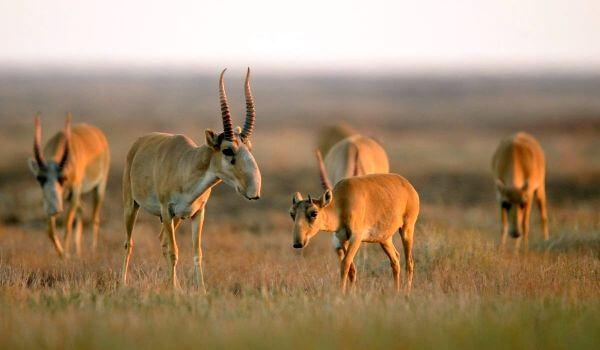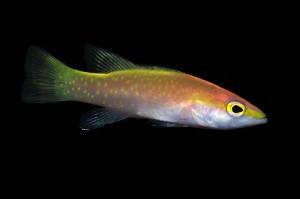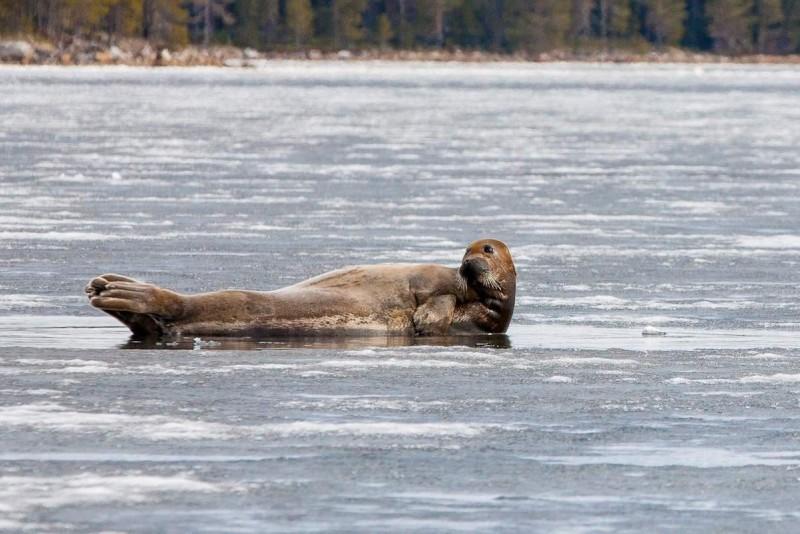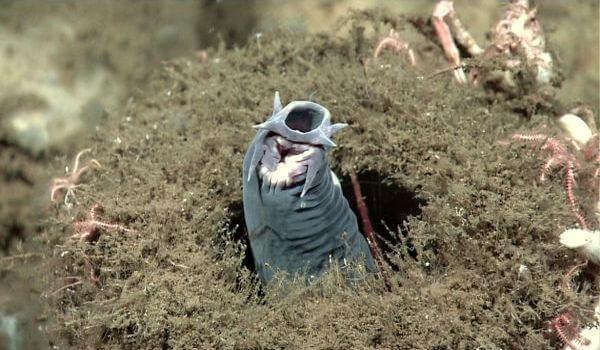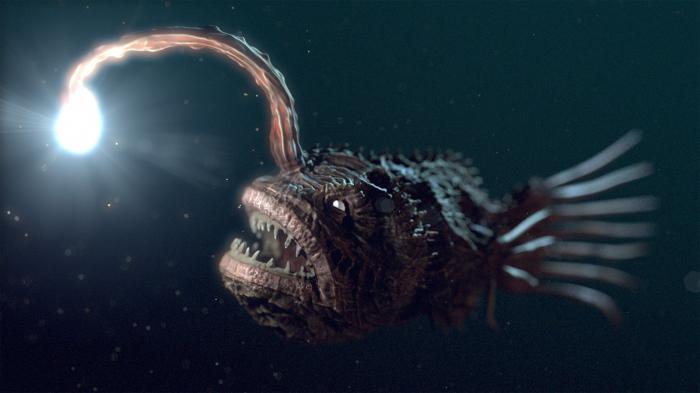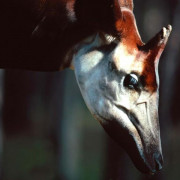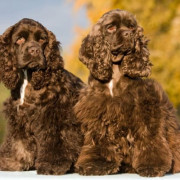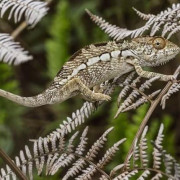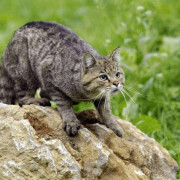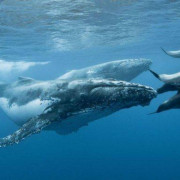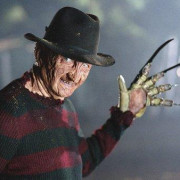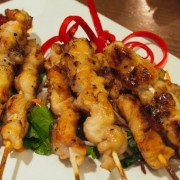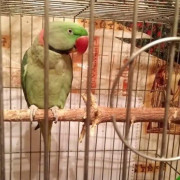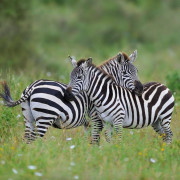Лучепёрые рыбы
Содержание:
- [править] Источники
- Reproduction
- Примечания
- Классификация
- Overview
- Эволюция
- Credits
- Подкласс лучеперые. Надотряд хрящекостные и костистые
- Происхождение земноводных
- Characteristics
- References
- Способы приготовления
- Classification
- Особенности строения лучеперых рыб
- Самые привлекательные экзотические рыбы
- Строение группы костистых рыб
[править] Источники
- Tree of Life Web Project. 2006. Chondrostei. Version 09 August 2006 (temporary). (англ.)
- ↑ Actinopteri // Brands, S.J. (comp.) 1989-present. Systema Naturae 2000. The Taxonomicon. Universal Taxonomic Services, Zwaag, The Netherlands.
- Ginglymodi // Brands, S.J. (comp.) 1989-present. Systema Naturae 2000. The Taxonomicon. Universal Taxonomic Services, Zwaag, The Netherlands.
- Tree of Life Web Project. 2006. Halecostomi. Version 07 August 2006 (temporary). (англ.)
- Классификация костистых рыб на сайте ITIS (англ.)
- Lundberg, John G. 2006. Teleostei. The Tree of Life Web Project. Version 18 August 2006 (temporary). (англ.)
- Lundberg, John G. 2006. Actinopterygii. The Tree of Life Web Project. Version 07 August 2006 (temporary). (англ.)
- Mickle K. E., R. Lund, and E. D. Grogan. 2009. Three new palaeoniscoid fishes from the Bear Gulch limestone (Serpukhovian, Mississippian) of Montana (USA) and the relationships of lower actinopterygians. Geodiversitas 31 (3): 623—668
- ↑ Mickle K. E. 2011. The early actinopterygian fauna of the Manning Canyon Shale Formation (Upper Mississippian, Lower Pennsylvanian) of Utah, USA. Journal of Vertebrate Paleontology, 31 (5): 962—980
|
Классы хордовых (Chordata) |
||||||||||||
|---|---|---|---|---|---|---|---|---|---|---|---|---|
| Эукариоты (Eukaryota) • Животные (Animalia) • Эуметазои (Eumetazoa) • Двусторонне-симметричные (Bilateria) • Вторичноротые (Deuterostomia) | ||||||||||||
| Бесчерепные (Acrania) | Ланцетники (Leptocardii) | |||||||||||
| Оболочники (Tunicata) | Асцидии (Ascidiacea) • Аппендикулярии (Larvacea) • Thaliacea | |||||||||||
| Позвоночные (Vertebrata)/Черепные (Craniata) |
|
|||||||||||
| * — парафилетический таксон, † — вымерший таксон |
Reproduction
Three-spined stickleback males (red belly) build nests and compete to attract females to lay eggs in them. Males then defend and fan the eggs. Painting by Alexander Francis Lydon, 1879
In nearly all ray-finned fish, the sexes are separate, and in most species the females spawn eggs that are fertilized externally, typically with the male inseminating the eggs after they are laid. Development then proceeds with a free-swimming larval stage. However other patterns of ontogeny exist, with one of the commonest being sequential hermaphroditism. In most cases this involves protogyny, fish starting life as females and converting to males at some stage, triggered by some internal or external factor. Protandry, where a fish converts from male to female, is much less common than protogyny.
Most families use external rather than internal fertilization. Of the oviparous teleosts, most (79%) do not provide parental care.Viviparity, ovoviviparity, or some form of parental care for eggs, whether by the male, the female, or both parents is seen in a significant fraction (21%) of the 422 teleost families; no care is likely the ancestral condition. Viviparity is relatively rare and is found in about 6% of teleost species; male care is far more common than female care. Male territoriality «preadapts» a species for evolving male parental care.
There are a few examples of fish that self-fertilise. The mangrove rivulus is an amphibious, simultaneous hermaphrodite, producing both eggs and spawn and having internal fertilisation. This mode of reproduction may be related to the fish’s habit of spending long periods out of water in the mangrove forests it inhabits. Males are occasionally produced at temperatures below 19 °C (66 °F) and can fertilise eggs that are then spawned by the female. This maintains genetic variability in a species that is otherwise highly inbred.
Примечания
- Богуцкая Н. Г., Насека А. М. Каталог бесчелюстных и рыб пресных и солоноватых вод России с номенклатурными и таксономическими комментариями. — М.: Товарищество научных изданий КМК, 2004. — 389 с. — ISBN 5-87317-177-7
- ↑
- ↑ Жизнь животных. В 7 т. / гл. ред. В. Е. Соколов. — 2‑е изд., перераб. — М. : Просвещение, 1983. — Т. 4 : Ланцетники. Круглоротые. Хрящевые рыбы. Костные рыбы / под ред. Т. С. Расса. — 575 с. : ил.
- ↑ Биологический энциклопедический словарь / Гл. ред. М. С. Гиляров; Редкол.: А. А. Баев, Г. Г. Винберг, Г. А. Заварзин и др. — М. : Сов. энциклопедия, 1986. — 831 с. — 100 000 экз.
- ↑ Лучепёрые рыбы // : / гл. ред. А. М. Прохоров. — 3-е изд. — М. : Советская энциклопедия, 1969—1978.
- ↑
- Mickle K. E., R. Lund, and E. D. Grogan. 2009. Three new palaeoniscoid fishes from the Bear Gulch limestone (Serpukhovian, Mississippian) of Montana (USA) and the relationships of lower actinopterygians. Geodiversitas 31 (3): 623—668
- ↑ Mickle K. E. 2011. The early actinopterygian fauna of the Manning Canyon Shale Formation (Upper Mississippian, Lower Pennsylvanian) of Utah, USA. Journal of Vertebrate Paleontology, 31 (5): 962—980
Классификация
Класс лучепёрых рыб разделяют на два подкласса: хрящевые ганоиды, или хрящекостные рыбы (Chondrostei) и новопёрые рыбы (Neopterygii).
Первый подкласс включает в себя более древние по происхождению отряды рыб. Большинство же отрядов принадлежит к более молодой группе — новопёрым рыбам. В этом подклассе выделяются 2 инфракласса: костные ганоиды (Holostei) и костистые рыбы (Teleostei).
Подкласс Хрящевые ганоиды, или Хрящекостные рыбы (Chondrostei) включает 2 современных и 12 ископаемых отрядов:
- Осетрообразные (Acipenseriformes)
- Многопёрообразные (Polypteriformes)
- † Палеонискообразные (Palaeonisciformes)
- † Cheirolepidiformes
- † Guildayichthyiformes
- † Luganiiformes
- † Peltopleuriformes
- † Perleidiformes
- † Platysomiformes
- † Phanerorhynchiformes
- † Pholidopleuriformes
- † Ptycholepiformes
- † Saurichthyiformes
- † Tarrasiiformes
Подкласс Новопёрые рыбы (Neopterygii)
-
Инфракласс Костные ганоиды (Holostei) — 7 отрядов, из которых 5 вымершие:
- † Macrosemiiformes — мезозойская эра
- † Pycnodontiformes — триас — начало кайнозоя
- † Semionotiformes — мезозойская эра
- Надотряд Ginglymodi — 1 отряд
Панцирникообразные (Lepisosteiformes)
:
- Надотряд Halecomorphi — 3 отряда:
- Амиеобразные (Amiiformes)
- † Parasemionotiformes — мезозойская эра
- † Ionoscopiformes — мезозойская эра
-
Инфракласс Костистые рыбы (Teleostei) — 12 современных надотрядов с 44 отрядами:
- Надотряд Араваноидные (Osteoglossomorpha) — 2 отряда:
- Араванообразные (Osteoglossiformes)
- Луноглазкообразные (Hiodontiformes)
- † Lycopteriformes
- Надотряд Элопсоидные (Elopomorpha) — 5 отрядов:
- Альбулеобразные (Albuliformes)
- Угреобразные (Anguilliformes)
- Спиношипообразные (Notacanthiformes)
- Тарпонообразные (Elopiformes)
- Мешкоротообразные (Saccopharyngiformes)
- Надотряд Клюпеоидные (Clupeomorpha) — 1 отряд
Сельдеобразные (Clupeiformes)
:
- Надотряд Костнопузырные (Ostariophysi) — 5 отрядов:
- Гоноринхообразные (Gonorynchiformes)
- Карпообразные (Cypriniformes)
- Харацинообразные (Characiformes)
- Гимнотообразные (Gymnotiformes)
- Сомообразные (Siluriformes)
- Надотряд Protacanthopterygii — 4 отряда:
- Аргентинообразные (Argentiniformes)
- Лососеобразные (Salmoniformes)
- Щукообразные (Esociformes)
- Корюшкообразные (Osmeriformes)
- Надотряд Stenopterygii — 2 отряда:
- Ложнодолгохвостообразные (Ateleopodiformes)
- Стомиеобразные (Stomiiformes)
- Надотряд Cyclosquamata
Аулопообразные (Aulopiformes)
— 1 отряд:
- Надотряд Scopelomorpha
Миктофообразные (Myctophiformes)
— 1 отряд:
- Надотряд Lampridiomorpha
Опахообразные (Lampriformes)
— 1 отряд:
- Надотряд Polymyxiomorpha
Барбудообразные (Polymixiiformes)
— 1 отряд:
- Надотряд Paracanthopterygii — 6 отрядов:
- Stylephoriformes
- Перкопсообразные (Percopsiformes)
- Батрахообразные (Batrachoidiformes)
- Ошибнеобразные (Ophidiiformes)
- Удильщикообразные (Lophiiformes)
- Присоскообразные (Gobiesociformes)
- Трескообразные (Gadiformes)
- Надотряд Колючепёрые (Acanthopterygii) — 15 отрядов:
- Кефалеобразные (Mugiliformes)
- Атеринообразные (Atheriniformes)
- Сарганообразные (Beloniformes)
- Карпозубообразные (Cyprinodontiformes)
- Стефанобериксообразные (Stephanoberyciformes)
- Бериксообразные (Beryciformes)
- Солнечникообразные (Zeiformes)
- Колюшкообразные (Gasterosteiformes)
- Иглообразные (Syngnathiformes)
- Ложноугреобразные (Synbranchiformes)
- Иглобрюхообразные (Tetraodontiformes)
- Скорпенообразные (Scorpaeniformes)
- Окунеобразные (Perciformes)
- Камбалообразные (Pleuronectiformes)
- Собачкообразные (Blenniiformes}
- Надотряд Араваноидные (Osteoglossomorpha) — 2 отряда:
Ископаемые отряды костистых рыб:
- † Araripichthyidae
- † Ichthyodectiformes — мезозойская эра
- † Leptolepidiformes — мезозойская эра
- † Pholidophoriformes — мезозойская эра
- † Tselfatiformes — меловой период
Ископаемые отряды лучепёрых рыб с неопределённой принадлежностью к подклассам:
- † Pachycormiformes — мезозойская эра
- † Aspidorhynchiformes — мезозойская эра
Ископаемые виды с неопределённой принадлежностью:
- Beagiascus pulcherrimus — ископаемая рыба, жившая около 320 млн лет назад на территории нынешнего штата Монтана. Вид был описан в 2009 году.
- Gunterichthys lehiensis — рыба, жившая в каменноугольном периоде на территории штата Юта, США. Описана в 2011 году.
- Spinofacia pectinatus — рыба, жившая в каменноугольном периоде на территории штата Юта, США. Описана в 2011 году.
Overview
Actinopterygii (the plural form of Actinopterygius) is commonly placed as a class of vertebrates (ITIS 2017; Jonna 2004; Nelson 1994), generally with the parent taxon Osteichthyes (the bony fish) listed as a superclass. In some classification schemes, however, Osteichthyes is listed not as a superclass but as a class, in which case Actinopterygii is listed as a subclass. Alternatively, Nelson (1994), while using Actinopterygii as a class, chooses not to use Osteichthyes as a formal taxon at all because it «is clearly not a monophyletic group.»
With such a great multitude of species, the Actinopterygians’ characteristics tend to be spread over a considerable range. Many, but not all, of the Actinopterygians, for example, have scales, which may be either the more primitive ganoid form(diamond-shaped, shiny, hard, and multilayered), or the more advanced cycloid or ctenoid forms, which overlap a bit like roof tiles from head to tail to reduce drag. Cycloid scales have smooth edges and ctenoid have rough edges. Other characteristics include nostrils set relatively high up on the head with internal nostrils absent, spiracle (a hole behind the eye through which some cartilaginous fish pump water to the gills) usually absent, pectoral radial bones attached to the scapulo-coracoid skeletal complex (except in Polypteriformes), interopercle and branchiostegal rays (bone-like infrastructure) usually present, and bony gular plate (protecting the throat and lower jaw) usually absent (Nelson 1994). This group is considered to be monophyletic. Extant species can range in size from Paedocypris, at 7.9 millimeters (0.3 inches), to the massive ocean sunfish, at 2,300 kilograms (5,100 lb), and the long-bodied aarfish, to at least 11 meters (36.1 feet).
Most bony fish belong to the Actinopterygii; there are only eight living species of lobe finned fish (class Sacopterygii), including the lungfish and coelacanths. Nelson (1994) and Jonna (2004) recognize 42 orders, 431 families, over 4,000 genera, and about 24,000 species of ray-finned fish. This is about half the number of species of known extant vertebrates. About 42 percent of the species of bony fish are known only or almost only from freshwater (Nelson 1994). However, species of fish are not only being continually discovered, but also some are believed to be becoming extinct faster than they can be discovered (Jonna 2004).
Actinopterygians are generally classified into two groups—the Chondrostei and the Neopterygii (Jonna 2004; Nelson 1994; ITIS 2018). The Chondrostei include paddlefishes, sturgeons, and bichirs (ITIS 2017). The Neopterygii include Amiiformes (bowfin), Semionotiformes or Lepisosteiformes (gars), and Teleostei (modern bony fishes). Most fish today fit into the Teleostei, with about 23,000 of the 24,000 actinopterygians being teleosts.
Other classifications of the Actinopterygians exist. For example, in addition to Chondrostei and Neopterygii, Lundberg (2006) also lists a taxon of Actinopterygii known as Cladistia, comprised of the bichirs, reedfishes, Polypteriformes, and Polypteridae.
Diversity
The ray-finned fish are extraordinarily diverse in terms of body form, color, habitat, behavior, and so forth. They live in almost all types of habitats with the exception of land that is constantly dry (and some species spend a considerable amount of time outside of water), including the depths of the ocean to 7,000 meters, subterranean caves, desert springs and ephemeral pools, high altitude lakes, and polar seas, and including temperatures from -1.8°C to nearly 40°C (28.8°F to nearly 104°F), salinities from 0 to 90 parts per million, pH levels from four to above ten, and dissolved oxygen levels down to zero (Jonna 2004). Actinopterygians may swim, walk, fly, or be immobile, they feed on nearly all types of organic matter, they exhibit a huge variety of colors, and they have different types of sensory systems, including vision, hearing, chemoreception, electroreception, lateral line sensation, and so forth (Jonna 2004). The electric eel and various other fish can produce electric organ discharges (EODs), which may be low voltage for electrolocation and high voltage to stun prey or offer protection.
Fossil record
The earliest known fossil actinopterygiian is Andreolepis hedei, dating back 420 million years (Late Silurian). This microvertebrate has been uncovered in Russia, Sweden, and Estonia (PD 2008). While appearing in the Devonian some 400 million years ago, actinopterygians did not become dominant in freshwaters until the Carboniferous (360 million years ago), when they started to invade the seas (Jonna 2004).
Эволюция
Поскольку все виды морских рыб и их пресноводных собратьев тщательно изучаются, то каждая археологическая находка в этой области представляет интерес для ученых. Так было установлено, что самый древний скелет ископаемых лучеперых рыб старше 420 млн. лет. По его строению определили, что это был хищник, относящийся к отряду палеонискообразных. Подобные находки попадались на территории России, Эстонии и Швеции.
Следующие важные находки оказались моложе более чем на 200 млн. лет. Это были скелеты первых костистых рыб, ставших прародителями огромного множества видов, названных впоследствии лучеперые рыбы. Возникновение большого количества видовых вариаций объясняется тем, что в ходе эволюции рыбы были вынуждены приспосабливаться к разным условиям и разному уровню солнечной радиации. Возникали родственные группы, которые были вынуждены адаптироваться к постепенным изменениям окружающего мира.
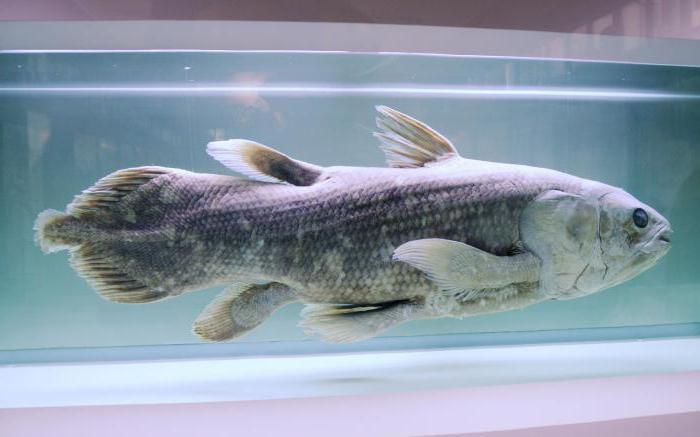
Credits
New World Encyclopedia writers and editors rewrote and completed the Wikipedia article
in accordance with New World Encyclopedia standards. This article abides by terms of the Creative Commons CC-by-sa 3.0 License (CC-by-sa), which may be used and disseminated with proper attribution. Credit is due under the terms of this license that can reference both the New World Encyclopedia contributors and the selfless volunteer contributors of the Wikimedia Foundation. To cite this article click here for a list of acceptable citing formats.The history of earlier contributions by wikipedians is accessible to researchers here:
Actinopterygii history
The history of this article since it was imported to New World Encyclopedia:
History of «Actinopterygii»
Note: Some restrictions may apply to use of individual images which are separately licensed.
Подкласс лучеперые. Надотряд хрящекостные и костистые
Название подкласс лучеперых
получил из-за особого строения плавников входящих в него рыб — тонкие косточки расходятся веером, множественными лучами. Кхрящекостным относитсяотряд осетровых (севрюга, шип, белуга, стерлядь и др.).
1. Эти довольно крупные рыбы с длинным узким телом имеют характерный рострум
— вырост в передней части головы.
2. Также им присущ несимметричный (гетероцеркальный)
хвостовой плавник с очень длинной верхней лопастью.
3. Позвонки не развиты, есть лишь верхние и нижние дуги, а толстая хорда
сохраняется на всю жизнь.
4. Вдоль тела тянутся ряды ромбовидных жучек
— костных бляшек.
5. Жабры прикрыты крышками
, естьплавательный пузырь .
6. Питаются осетровые различными беспозвоночными.
7. Оплодотворение наружное
. Осетровые невероятно плодовиты, крупные особи могут образовать до миллиона икринок. Разные виды легко скрещиваются между собой, а самыми живучими оказались потомки белуги. Так был выведенбестер — гибрид белуги и стерляди.
8. По характеру обитания осетровые бывают пресноводными и проходными. Атлантический осетр
живет в соленых водах — в Атлантике, в Северном море, в Балтике, однако встречали его, по некоторым данным, и в Северной Двине.
Подкласс лучеперые. Надотряд костистые
Самая «густонаселенная» группа, включает почти 90 процентов современных видов рыб, обитающих повсеместно, в том числе на больших глубинах. В позвоночнике у костистых сохраняются фрагменты хорды. Череп построен из костной ткани и содержит много отдельных мелких костей. Тело, как правило, покрыто костными пластинами или шипами, но встречаются и рыбы без чешуи, например, ошибень. Упомянем здесь самые известные отряды костистых рыб.
1. Отряд сельдеобразных
включает сельдей, анчоусов, сардин, шпрот и другие семейства. Это довольно примитивные по строению рыбы, у них легко отделяется чешуя и не полностью окостеневший череп.
2. Отряд лососееобразных
включает только односемейство лососевых : кета, ленок, чавыча, нерка, семга, омуль, горбуша — это ценные промысловые рыбы с высокими вкусовыми и питательными качествами. Близкой родственницей лососеобразных является щука.
3. Отряд карпообразных
объединяет большое количество видов, его представители, как хищники, так и растительноядные, обитают в пресных водах. Карп, повсеместно разводимый в рыбхозяйствах — это одомашненная форма сазана.
4. Отряд трескообразных
включает более 600 видов морских рыб. Исключением является пресноводный налим. У тресковых особые плавники — они не имеют колючих лучей.
Хочешь сдать экзамен на отлично? Жми сюда — репетитор онлайн: биология ЕГЭ
Происхождение земноводных
Основная статья: Происхождение земноводных
Биологи полагают, что кистепёрые рыбы дали начало земноводным и первыми из позвоночных вышли на сушу. Большинство исследователей считают более вероятным монофилетическое происхождение тетрапод от остеолепиформных лопастепёрых, хотя при этом допускается возможность полифилии, то есть достижения уровня организации земноводных несколькими близкородственными филетическими линиями остеолепиформных рыб, эволюционировавшими параллельно. Параллельные линии скорее всего вымерли. Одной из наиболее «продвинутых» лопастепёрых рыб являлся тиктаалик (Tiktaalik), имевший ряд переходных признаков, сближающих его с земноводными.
Characteristics
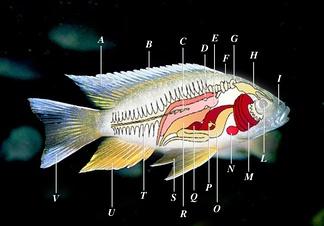
Anatomy of a typical ray-finned fish (cichlid) A−dorsal fin, B−fin rays, C−lateral line, D−kidney, E−swim bladder, F−Weberian apparatus, G−inner ear, H−brain, I−nostrils, L−eye, M−gills, N−heart, O−stomach, P−gall bladder, Q−spleen, R−internal sex organs (ovaries or testes), S−ventral fins, T−spine, U−anal fin, V−tail (caudal fin). Possible other parts not shown: barbels, adipose fin, external genitalia (gonopodium)
Ray-finned fishes occur in many variant forms. The main features of a typical ray-finned fish are shown in the adjacent diagram.
Ray-finned fishes have many different types of scales; but all teleosts, the most advanced actinopterygians, have leptoid scales. The outer part of these scales fan out with bony ridges while the inner part is crossed with fibrous connective tissue. Leptoid scales are thinner and more transparent than other types of scales, and lack the hardened enamel or dentine-like layers found in the scales of many other fish. Unlike ganoid scales, which are found in non-teleost actinopterygians, new scales are added in concentric layers as the fish grows.
References
- Froese, R., and D. Pauly (eds.). 2018. FishBase Fishbase.org. Retrieved June 25, 2018.
- Integrated Taxonomic Information System (ITIS). 2017. Actinopterygii ITIS Taxonomic Serial No.: 161061. Retrieved June 25, 2018.
- Integrated Taxonomic Information System (ITIS). 2018. Neopterygii ITIS Taxonomic Serial No.: 553120. Retrieved June 25, 2018.
- Johnson, G. D., and E. O. Wiley. 2007. Percomorpha Tree of Life. Retrieved June 25, 2018.
- Jonna, R. 2004. Actinopterygii Animal Diversity Web. Retrieved June 25, 2018.
- Lundberg, J. G. 2006. Actinopterygii. The ray-finned fishes Tree of Life Version 07 August 2006 (temporary). Retrieved June 25, 2018.
- Nelson, J. S. 2006. Fishes of the World. John Wiley & Sons. ISBN 0471250317.
- Nelson, J. S. 1994. Fishes of the World, 3rd ed. New York: John Wiley & Sons. ISBN 0471547131.
- Paleontology Database (PD). 2008. Andreolepis Paleontology Database. Retrieved June 25, 2018.
Способы приготовления
Как готовят рыбу чир? Ее варят, готовят на пару, жарят, запекают, тушат, солят, вялят и маринуют, используют для приготовления рыбных супов и наваристой ухи. Благодаря сочности и минимуму костей мясо щекура служит идеальной начинкой для пирогов. Из него получаются вкусные пельмени и котлеты. Жители Севера едят рыбу и в сыром виде (в ее мясе нет паразитов), делая сугудай, рубанину и строганину. Оригинально смотрится рулет из белого мяса чира и красного мяса горбуши или семги.
Чир фаршированный
Но настоящим деликатесом считается копченый щокур. Особенно ценится продукт холодного копчения благодаря нежному и изысканному вкусу. Он отлично сочетается со сметаной, грибами, овощами, сыром. Подают копченое мясо и с некоторыми фруктами.
Classification
A listing of the different groups is given below, down to the level of orders, arranged in what has been suggested to represent the evolutionary sequence down to the level of order based primarily on the long history of morphological studies. This classification, like any other taxonomy based on phylogenetic research is in a state of flux. Many of these ordinal and higher-level groupings have not been supported in both the recent morphological and molecular literature. Examples of demonstrably paraphyletic or unnatural groups include the Paracanthopterygii, Scorpaeniformes, and Perciformes (Johnson and Wiley 2007). The listing follows Froese and Pauly (2018), with notes when this differs from Nelson (2006) and ITIS (2017).
-
Subclass Chondrostei
- Order Polypteriformes, including the bichirs and reedfishes
- Order Acipenseriformes, including the sturgeons and paddlefishes
-
Subclass Neopterygii
-
Infraclass Holostei
- Order Lepisosteiformes, the gars
- Order Amiiformes, the bowfins
-
Infraclass Teleostei
-
Superorder Osteoglossomorpha
- Order Osteoglossiformes, the bony-tongued fishes
- Order Hiodontiformes, including the mooneye and goldeye
-
Superorder Elopomorpha
- Order Elopiformes, including the ladyfishes and tarpon
- Order Albuliformes, the bonefishes
- Order Notacanthiformes, including the halosaurs and spiny eels
- Order Anguilliformes, the true eels and gulpers
- Order Saccopharyngiformes, including the gulper eel
-
Superorder Clupeomorpha
Order Clupeiformes, including herrings and anchovies
-
Superorder Ostariophysi
- Order Gonorynchiformes, including the milkfishes
- Order Cypriniformes, including barbs, carp, danios, goldfishes, loaches, minnows, rasboras
- Order Characiformes, including characins, pencilfishes, hatchetfishes, piranhas, tetras.
- Order Gymnotiformes, including electric eels and knifefishes
- Order Siluriformes, the catfishes
-
Superorder Protacanthopterygii
- Order Salmoniformes, including salmon and trout
- Order Esociformes the pike
- Order Osmeriformes, including the smelts and galaxiids
-
Superorder Stenopterygii
- Order Ateleopodiformes, the jellynose fish
- Order Stomiiformes, including the bristlemouths and marine hatchetfishes
-
Superorder Cyclosquamata
Order Aulopiformes, including the Bombay duck and lancetfishes
-
Superorder Scopelomorpha
Order Myctophiformes, including the lanternfishes
-
Superorder Lampridiomorpha
Order Lampriformes, including the oarfish, opah and ribbonfishes
-
Superorder Polymyxiomorpha
Order Polymixiiformes, the beardfishes
-
Superorder Paracanthopterygii
- Order Percopsiformes, including the cavefishes and trout-perches
- Order Batrachoidiformes, the toadfishes
- Order Lophiiformes, including the anglerfishes
- Order Gadiformes, including cods
- Order Ophidiiformes, including the pearlfishes
-
Superorder Acanthopterygii
- Order Mugiliformes, the mullets
- Order Atheriniformes, including silversides and rainbowfishes
- Order Beloniformes, including the flyingfishes
- Order Cetomimiformes, the whalefishes
- Order Cyprinodontiformes, including livebearers, killifishes
- Order Stephanoberyciformes, including the ridgeheads
- Order Beryciformes, including the fangtooths and pineconefishes
- Order Zeiformes, including the dories
- Order Gobiesociformes, the clingfishes
- Order Gasterosteiformes including sticklebacks, pipefishes, seahorses
- Order Syngnathiformes, including the seahorses and pipefishes
- Order Synbranchiformes, including the swamp eels
- Order Tetraodontiformes, including the filefishes and pufferfish
- Order Pleuronectiformes, the flatfishes
- Order Scorpaeniformes, including scorpionfishes and the sculpins
- Order Perciformes 40 percent of all fish including anabantids, Centrarchids (incl. bass and sunfish), Cichlids, gobies, gouramis, mackerel, perches, scats, whiting, wrasses
-
Superorder Osteoglossomorpha
-
Infraclass Holostei
Особенности строения лучеперых рыб
Среди костных рыб есть еще и подкласс лопастепёрых, в отличие от которых лучеперые имеют позвоночник костный. Только у немногих из них сохранилась хорда или её остатки.
Костный позвоночник является опорой скелета лучеперых рыб, состоящего из нескольких опорных элементов. В скелете отсутствует центральная ось. Важная особенность этих рыб – строение их мозга, в котором эпителиальная крыша передней его части не имеет нервного вещества.
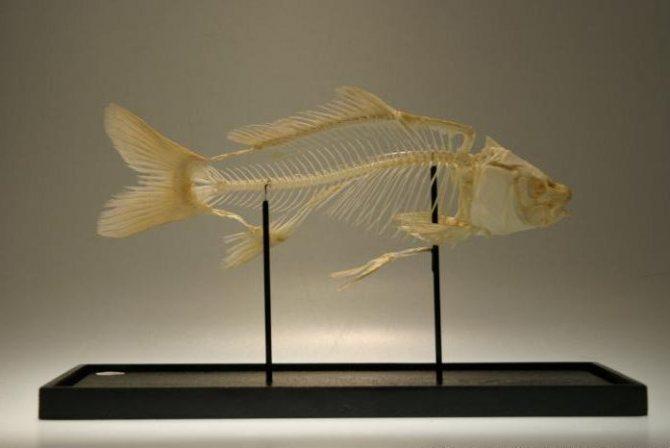
Чешуя лучеперых рыб имеет вид пластинок костных, в то время как примитивные рыбы имеют чешую, покрытую ганоином, благодаря которому они имеют возможность быстрее передвигаться и маневрировать среди многочисленных кораллов. Кроме того что плавники грудные помогают менять направление движения, они еще имеют ряд и других важных функций. К примеру, рыбы с их помощью вентилируют свою икру во время размножения.
У описываемого вида чаще всего задний плавник один, но иногда их бывает два или даже три.
У более древних представителей данного класса рыб хвост гетероцеркальный, а у представителей более молодых видов – онгомоцеркальный.
Как правило, лучеперые рыбы обладают плавательным пузырем. Но он может у некоторых из них отсутствовать. Это зависит от отряда рыб. Мочеполовое и анальное отверстия разделены.
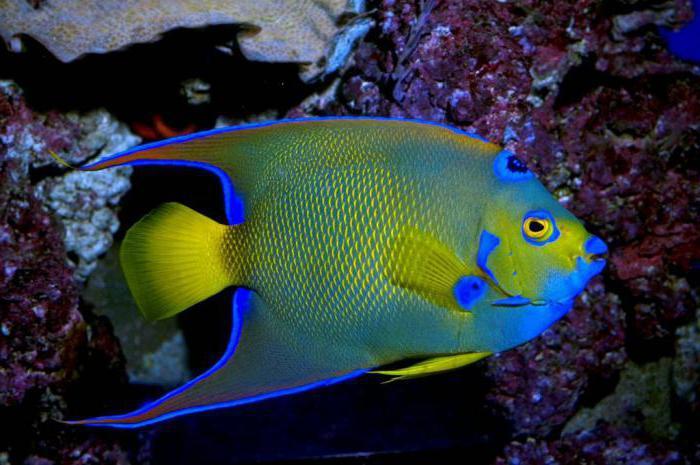
Самые привлекательные экзотические рыбы
Среди вышеописанных рыб (лучеперые рыбы) есть удивительно привлекательные виды:
• Рыба мурджан отличается огромными выразительными глазами, красиво выделяющимися на фоне основного розоватого окраса.
• Морской окунь, отличающийся от речного собрата наличием в железах его острых плавников ядовитого вещества, имеет внешний вид, напрямую зависящий от глубины его обитания.
• Японский конек морской многими используется для украшения аквариумов. Эта рыба обладает необычной способностью – она издает сильные звуки (частота до 4800 Гц), которые хорошо воспринимаются ухом человека.
• Рыбы ангелы – главное украшение бесконечных загадочных морских глубин. Отличаются они яркими полосами и сеточками на чешуе. Обычно эти теплолюбивые рыбы обитают в районах с тропическим климатом.

• Скалярия является обитательницей практически всех аквариумов. Отличительная особенность этих красивых рыб заключается в том, что при смерти одной из пары, вторая уже остается одна, но часто одинокие заканчивают жизнь самоубийством.
• Рыбка лабеотрофеус обладает яркой, привлекательной окраской, особенно самцы. Следует отметить, что рыбы эти свою икру вынашивают во рту, в связи с чем в этот период самки не употребляют пищу.
Строение группы костистых рыб
Вторая группа является наиболее прогрессивной. Тело костистых рыб покрыто тонкими округлыми костными пластинками, которые в народе называют чешуей. Расположены чешуйки по принципу черепицы. На них различимы кольца прироста, по которым можно определить возраст особи.
Остевой скелет состоит из отдельных окостеневших позвонков, которые соединены связками, позволяющими изгибаться телу рыбы. Каждый сегмент позвоночника, кроме цилиндрической части, имеет дугу с остистым отростком. Назначение верхних дуг позвонков – создание канала для защиты спинного мозга. Вниз от позвонков направлены поперечные отростки, к которым крепятся реберные кости.
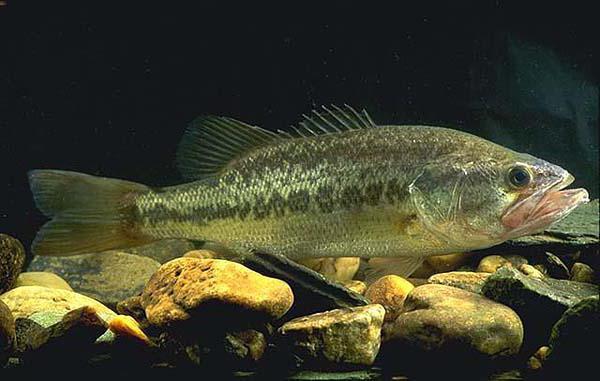
Лучеперые рыбы из группы костистых имеют хорошо сформированный череп, состоящий из большого количества костей. Мозг защищен костной коробкой. С костями позвоночника череп соединен неподвижно.
Опорно-двигательная система сформирована скелетом и мышцами, которые приводят в движение плавники, жаберные крышки, челюсти. Перемещаются лучеперые рыбы благодаря хвостовому отделу с крупным плавником. Устойчивость и прямолинейность во время движения обеспечивают непарные плавники. А парные плавники сохраняют правильное положение тела в воде и служат рулями поворота.
